#treeguidance
Explore tagged Tumblr posts
Text
#Trees in Delhi#Common trees in Delhi#DelhiTrees#TreeIdentification#TreeSpecies#NatureInDelhi#TreeAppreciation#UrbanGreenery#TreeDiversity#TreeGuide#DelhiFlora#TreeLovers#delhitourguide#delhi tour guide contact:9811500757
0 notes
Photo

Fiery Momiji “Japanese red maple in the cultivar group atropurpureum is a versatile, ornamental, hardy small tree or multi-stemmed shrub. The deeply lobed 5-7-9 leaves are red or reddish-purple in spring and again in fall. In between, color varies from remaining red all summer to sometimes fading slightly with maturity or summer heat and even turning green.” Excerpt from Japanese Red Maple Acer palmatum var. atr - https://www.arborday.org/trees/treeguide/TreeDetail.cfm?ItemID=866 . . . . . . . . . . . . #iger #igerph #igermanila #igerphilippines #osaka #japan2022 #japan #autumn #autumn2022 #travel #travelphoto #travelphotography #solotravel #hiroshima #itsukushima #miyajima #momiji #japanesemaple mapletree #iphonephoto #iphonephotography #iphone12promax #iphone12 https://www.instagram.com/p/CnJ0Z1Wp41v/?igshid=NGJjMDIxMWI=
#iger#igerph#igermanila#igerphilippines#osaka#japan2022#japan#autumn#autumn2022#travel#travelphoto#travelphotography#solotravel#hiroshima#itsukushima#miyajima#momiji#japanesemaple#iphonephoto#iphonephotography#iphone12promax#iphone12
3 notes
·
View notes
Photo

The Japanese Maple This is a Japanese Maple Tree, the species Acer palmatum, found in Portland, Oregon. The species has been cultivated around the world in many varieties and is, for obvious reasons, famous in part for the brilliant colors its leaves turn during the fall. -JBB Image credit: https://www.flickr.com/photos/scottmccracken/8278665481/ Read more: http://www.arborday.org/trees/treeguide/TreeDetail.cfm?id=29&trackingID=1819 http://www.mendocinomaples.com/index.php http://www.newyorker.com/magazine/2014/09/15/japanese-maple http://www.waysidegardens.com/wg-acer-how-to/a/329/
330 notes
·
View notes
Photo

Monterey Pine coupled with the Queen of Cups this morning... Monterey pine 🌲 signifies strength of purpose and reminds you to connect to your own inner purpose while queen of cups, the mother of mothers, tells us we can mother ourselves. Redirect your nurturing, mothering energy towards yourself and reap the rewards of your own inner guidance. #queenofcups #montereypine #tarotreadersofinstagram #treewisdom #treeguidance #wisdomoftrees #wisdomoftreesoracle #fountaintarot #tarot #thedailydraw #dailytarot #tarotwisdom #tarotguidance #mysticapothecary #dailyceremony
#mysticapothecary#montereypine#tarotwisdom#tarotreadersofinstagram#dailyceremony#wisdomoftrees#queenofcups#treeguidance#wisdomoftreesoracle#tarot#thedailydraw#tarotguidance#treewisdom#fountaintarot#dailytarot
0 notes
Photo







Fagus sylvatica “pendula” / Weeping European Beech
Family: Fagaceae
Native: England, but can be found in nature in Maine, Massachusetts, Rhode Island, & Connecticut
Mature Size: 50-60ft height; 35-50ft spread
Habitat: Woodland garden canopy, forests, forests edges; anthropogenic (man-made or disturbed habitats),
Hardiness Zone: 4-7
Leaf Color: Dark green; reddish or coppery-brown in the fall;
Flower color/Bloom time: Yellowish-Green; April-May
The European Beech is not ideal for holding a treehouse among its branches as the drooping trajectory away from the central trunk would not support a structural load. However, this tree grows tall with a dense, upright-oval to rounded-spreading crown of branches that droop low and can reach the ground. This combination of height with droopy can create an interior space in-between the trunk and the drooping branches touching the ground. The branching system of the European Beech is also known as a shade tree for it’s shading qualities both around and under the tree.
A possible treehouse-like structure could in fact be a wooden deck structure that is slightly off the ground as not to disturb the root system or ground ecosystem. This could be effective in wetland areas, where European Beech’s like to grow, to provide a dry decking structure protected by the tree. The walls and roof of this “treehouse” would be provided by the European Beech, and could effectively diffuse light, wind, and rain in a full canopy European Beech tree. This would be the case even into the winter as the leaves persist throughout the winter, providing a shelter from the elements in all seasons.
The wood of this tree is known for being used to construct furniture, flooring, or turnery - however, the exposed wood of the European Beech is not suitable for the outdoors. This tree can not be used as a material for a tree house.
Potential Enclosure Structure:
Diagrammatic Idea

Industry Precedent: The deck in this example respects the ground plane well, however the openings for trees should be even larger. In the specific case of the Weeping European Beech, the drooping branches would form a “wall” and create a sense of enclosure around the edge of the deck. The deck would be built in response to this line of enclosure.
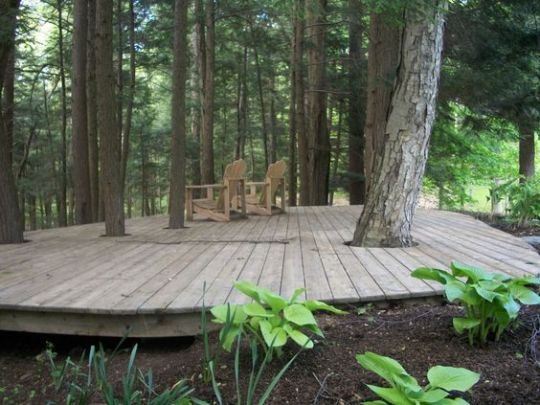
https://pin.it/map6y76irs2gum
Sources:
Go Botany https://gobotany.nativeplanttrust.org/species/fagus/sylvatica/
Missouri Botanical Garden http://www.missouribotanicalgarden.org/PlantFinder/PlantFinderDetails.aspx?kempercode=a866
Arbor Day https://www.arborday.org/trees/treeguide/treedetail.cfm?itemID=790
North Carolina Plant Toolbox https://plants.ces.ncsu.edu/plants/fagus-sylvatica-f-pendula/
Plants for a Future https://pfaf.org/user/plant.aspx?LatinName=Fagus+sylvatica
2 notes
·
View notes
Text
Ilex opaca

Ilex opaca Common name: American holly
This is a mature holly tree, standing at about 30 feet tall - a big feat for a slow-growing plant. Despite its stature, this tree still has the signature bright green spiny leaves and scarlet berries of holly plants: You can also note that its leaves present an alternate arrangement.
This tree can grow up to 50 feet tall but can be kept pruned as a hedge. It grows at a slow to medium rate, from less than 12″ to 24″ inches per year. Ilex opaca is native to Eastern North America. Raw berries are toxic to humans they are a valuable food source for animals), but Native Americans would preserve the berries to use in trade. The holly plant is dioecious, so there must be a male and female plant present to fertilize flowers. The wood of the holly tree is valuable for fine furniture and inlay work. This is also a signature decorative plant for Christmas celebrations.
Growth preferences:
Full sun to partial shade
Moist, acidic, rich, well-drained loamy/clay/sandy soils (some flood tolerance and drought resistance)
Hardy in Zones 5 through 9
Web references:
https://www.arborday.org/trees/treeguide/TreeDetail.cfm?ItemID=1071
https://www.uky.edu/hort/American-Holly
These photos were taken at Mount Auburn Cemetery in Massachusetts on November 4, 2020



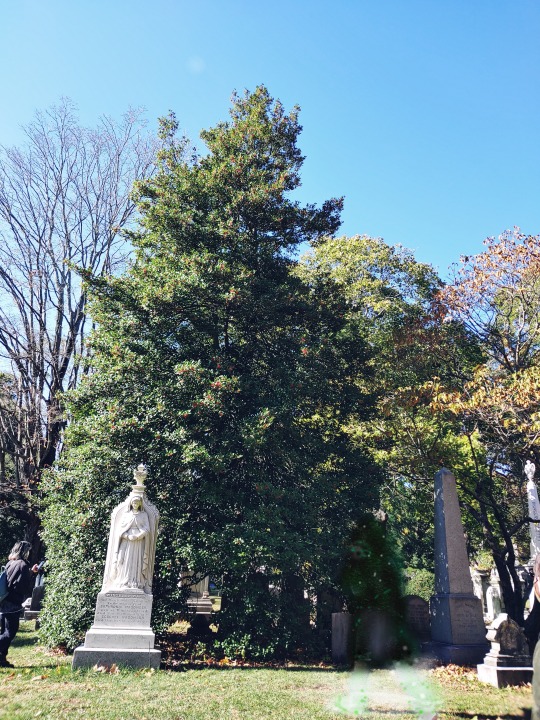
0 notes
Photo

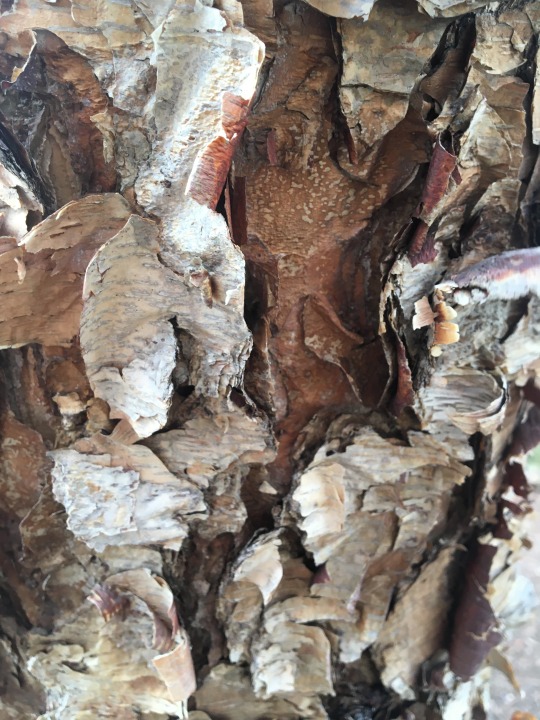



River Birch
Betula nigra
Photographed at Northeastern
Preferred Solar Exposure: Full sun/Partial shade
Preferred Soil Type: Moist, Well-drained soil
Cold Hardiness: Zones 4-9
best foliage color occurs in full sun
species has been known to tolerate flooded conditions for extended periods of time
tends to shed interior leaves during summer droughts and dry periods and can become stressed by summer heat and humidity
graceful branches, is easy to transplant, is heat tolerant and moderately salt tolerant
either a single trunk or multi-trunked tree
tends to drop lots of twigs, making it better suited for less manicured areas of the landscape
https://www.arborday.org/trees/treeguide/TreeDetail.cfm?ItemID=792
0 notes
Photo

On October 28 I took a trip to Harvard’s Arnold Arboretum in Roxbury, in the south of Boston on an absolutely dismal day to look at some attractive ornamental trees.
This large tree is a Magnolia x soulangeana, or Saucer Magnolia. In the late fall, it was characterized by the dense cover of its large, almost leathery leaves. It is a hybrid species of several Asian tree species. Until reaching full maturity, it is a small, low-branched tree with large pinkish-white flowers that are shaped like saucers (hence the common name) and bloom in early spring.
The tree can be expected to grow in USDA hardiness zones from 4-9 and prefers moist, deep, acidic soil as well as full sun. It has some drought tolerance. Under optimal conditions, the tree can be expected to grow 13-24″ in height per day. Additionally, it has some tolerance to urban air pollution.
Depending on how the tree is pruned, it can appear as either a large tree (pictured) or a small shrub. A variety of birds nest on the larger branches of the tree and eat the seeds. Due to its solar requirements, it is often used as a focal statement tree, though its thin bark can be easily damaged by lawn equipment.
Information source:
https://www.arborday.org/trees/treeguide/TreeDetail.cfm?ItemID=862
https://www.mortonarb.org/trees-plants/tree-plant-descriptions/saucer-magnolia
Found in Roxbury MA
ID with plant tag
0 notes
Photo




Gymnocladus dioica (Kentucky Coffee Tree)
Plant community: Eastern Flood plains
Native status: Native to the eastern United States
Mature size (height & width):
Height: 60-80 ft
Width: 40-55 ft
Habitat/ Tolerances
Drought tolerant
Heat tolerant
Pollution tolerant
Tolerant of urban conditions
Pest resistant
Disease resistant
Eco-indicator:
Hardiness zone: 3-8
Leaf color: Blue-green leaves which turn yellow in the fall
Flower color / bloom time: Greenish-white blooms which come out between May and June
Response to Climate Change:
Due to the Kentucky Coffeetree’s tolerances to heat and drought researchers predict the coffee tree will increase in abundance within the canopies of flood plain ecosystems due to their preference for warmer and drier conditions brought by climate change.
Potential Climate applications:
The Kentucky coffee tree is commonly planted in the urban environment due to it’s tolerances to pollution and urban conditions. Its adaptability to drought makes it an ideal candidate to plant in urban areas and habitats expected to experience temperature rise and drought. The tree will be useful to help adapt floodplain ecosystems and cities to climate impacts.
Climate Adaption Rank: 7
Sources:
https://www.hrwc.org/wp-content/uploads/Gymnocladus_dioicus.pdf https://www.arborday.org/trees/treeguide/TreeDetail.cfm?ItemID=819
http://www.missouribotanicalgarden.org/PlantFinder/PlantFinderDetails.aspx?kempercode=a872
#kentuckycoffeetree#arnoldarboretum#droughttolerant#native#heattolerant#urbantolerant#diseaseresistant#pestresistant#superclimateplant
0 notes
Photo








Bumblebee
https://images.fineartamerica.com/images/artworkimages/mediumlarge/2/bumblebee-on-redbud-flower-trina-ansel.jpg
Eastern Redbud Cercis canadensis
Family:
Fabaceae
Plant Community:
Oak Hickory Forest
Regions:
Native to Eastern and Central North America
Mature Size:
Height: 20′ to 30′
Width: 25′ to 35′
Habitat:
Commonly found as an understory tree in open woodlands and woodland edges. Prefers semi-rich, moist, well-drained soils. Intolerant to wet soils.
Hardiness Zone:
4 to 8
Leaf Color:
Summer - Dull blue/green
Fall - Pale yellow/green
Flowers:
Color - Pink
Bloom - April
Nesting:
Birds:
Cercis canadensis provides suitable nesting habitat for many species of bird.
Mammals:
Cercis canadensis provides suitable coverage for small mammals.
Insects:
Bumblebees use Cercis canadensis for both nesting material and as a host plant for hives.
Henry’s Elfin Butterfly - Adults lay eggs in the center of the holly leaf. Caterpillars eat leaves and buds, and pupate in groups at the base of the host tree.
Sources:
https://www.missouribotanicalgarden.org/PlantFinder/PlantFinderDetails.aspx?kempercode=h550
https://projects.ncsu.edu/goingnative/howto/mapping/nplants/plant_detail.php?id=559
https://www.wildflower.org/plants/result.php?id_plant=ceca4
https://www.fs.fed.us/database/feis/plants/tree/cercan/all.html
https://plants.usda.gov/factsheet/pdf/fs_ceca4.pdf
https://www.arborday.org/trees/treeguide/treedetail.cfm?itemID=912
https://www.butterfliesandmoths.org/species/Callophrys-henrici
0 notes
Text
Picea abies

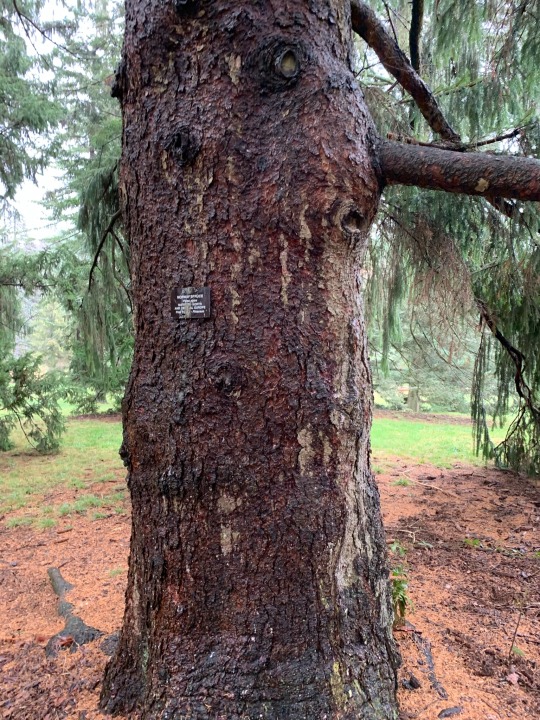


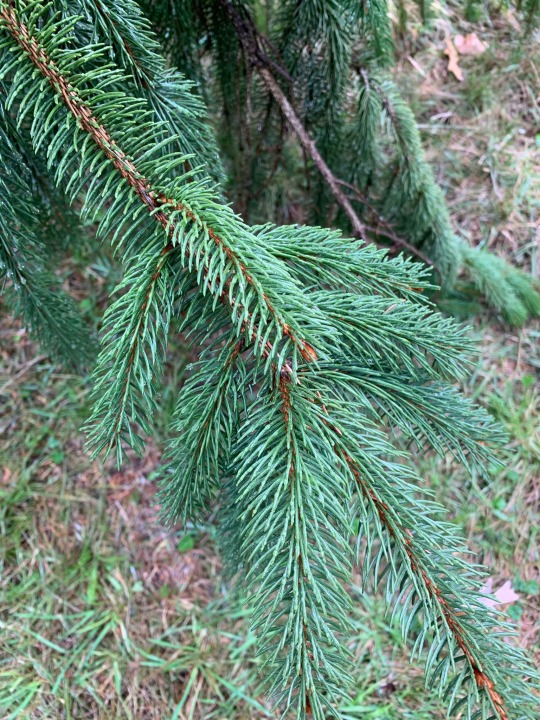
Norway Spruce
Picea abies
Type: Needled evergreen Family: Pinaceae Native Range: Europe Zone: 2 to 7 Height: 40-60 feet Spread: 25-30 feet Bloom Time: Non-flowering Bloom Description: Non-flowering Sun: Full sun Water: Medium Maintenance: Low
BUILD/BEAUTY
This coniferous tree is located at the Arnold Arboretum, high up on the evergreen hill. The Norway pine is a great looking tree, and this specimen is no exception. The needles of this tree are arranged in a cylinder type formation, encompassing the entire twig 360 degrees around. It very well may have been just the lighting but these needles appeared waxy and blue green under the overcast skies. The needles look great and earn a 3 out of 4 for its category. The bark, similar to that of many other pines, is reddish hued, and plated. Also to note, this tree gives off plenty of resin, which can be seen on the placard. I will award a 2 out of 3 for the bark. For landscape uniqueness, this tree gets a 2 out of 3, as the tall airy form works well in this landscape among other conifers, but would also look real cool by its self in a field. The combined score the Norway Spruce gets is a 7 out of 10 for beauty.
Bark: (1-3) 2
Leaves: (1-4) 3
Landscape uniqueness: (1-3) 2
Total: 7
The Norway Spruce’s wood is relatively soft, at only 380lbs on the Janka hardness scale. The wood is easily workable but you need straight lumber and grains to avoid a tear out. The wood doesn’t stain well due to the closed pore structure. The main uses of this tree include paper, construction lumber, Christmas trees, and musical instruments. The wood is used in framing construction, in that it has good compressible strength, and hard wood isn’t essential for that. This tree does have some construction benefits, so It will be receiving a rating of 8 out of 10 for buildability.
Source:
1. https://www.arborday.org/Trees/TreeGuide/treedetail.cfm?itemID=924
2. https://www.mortonarb.org/trees-plants/tree-plant-descriptions/norway-spruce
3. http://www.missouribotanicalgarden.org/PlantFinder/PlantFinderDetails.aspx?kempercode=e620
4. https://www.wood-database.com/norway-spruce/
0 notes
Text
Sawleaf Zelkova
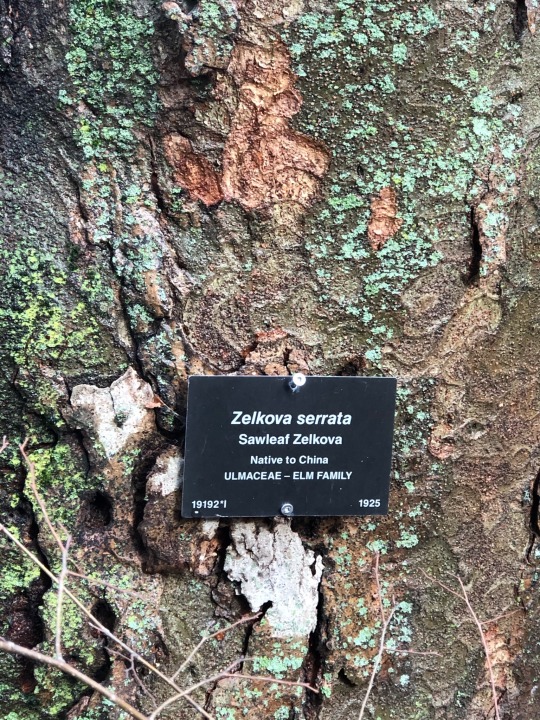



Zelkova serrata
Type: Tree
Native Range: China
Mature Size: 50 - 80 feet in height and 50 - 80 feet in spread
Habitat: Medium well-drained soils in full sun and moist to wet loams
Hardiness Zone: USDA 5-8
Leaf Color: Summer: Bright Green Fall: Light Brown
Flower Color: Insignificant
Bloom Time: March to April



image source: https://selectree.calpoly.edu/tree-detail/zelkova-serrata-musashino
The branches are thick, barky, and straggle out from the trunk. The leaves are densely scattered throughout the branch. The sawleaf zelkova is best used for shading walkways and large spaces below the trunk because of their top-heavy profile. It is also adequate for shading top stories of medium sized buildings while allowing a view from the lower levels. It also grows at a moderately slow rate which will makes it tough for immediate shading.
source: https://www.missouribotanicalgarden.org/PlantFinder/PlantFinderDetails.aspx?kempercode=a927
https://selectree.calpoly.edu/tree-detail/zelkova-serrata-musashino
https://www.arborday.org/trees/treeguide/TreeDetail.cfm?ItemID=941
0 notes
Photo
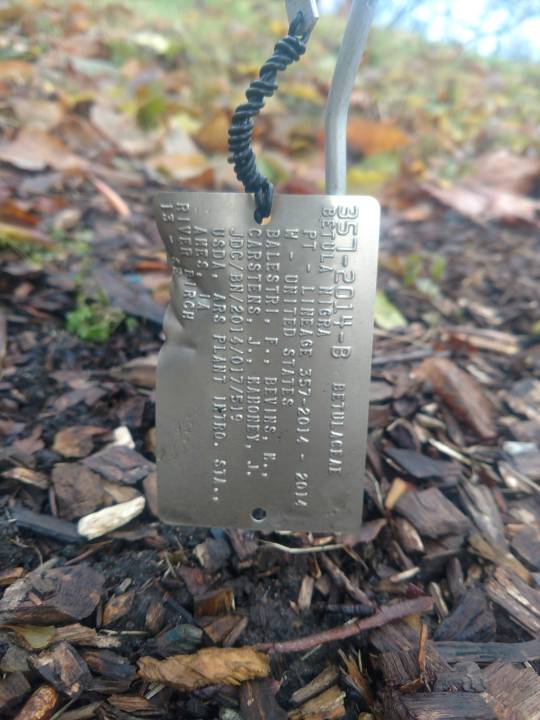
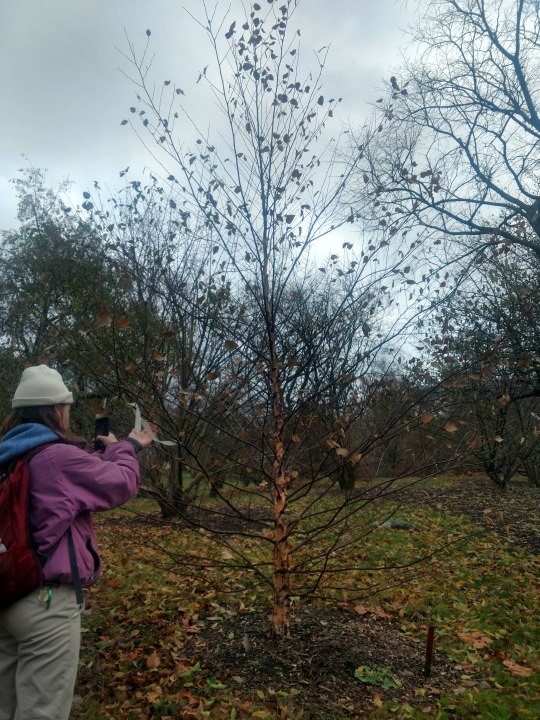



River Birch • Betula nigra
Plant Community: Spontaneous Urban Growth
Native Status: Native to the eastern United States
Mature Size (h, w): 40-70 ft, 40-60 ft
Habitat/Preferred Conditions: Full sun to partial shade. Prefers medium-moist, acidic soils. Tolerant of heat. Tolerant of both drought and flooding. Highly adaptive and easily grown.
Eco-indicator: N/A
Hardiness zone: 4-9
Leaf Color: Green (Summer), Brown (Fall)
Flower Color: Brown (male), Green (female)
Bloom Time: April-May
Theme:
The showy flowers of this tree are known to attract birds who often consume the mast later in the year. Specifically, Redpolls

https://en.wikipedia.org/wiki/Common_redpoll
and Pine Siskins.

http://celebrateurbanbirds.org/learn/birds/focal-species/pine-siskin/
Grouse and turkeys also consume the mast.
Butterflies and other insect pollinators are also attracted to the bright flowers of the River Birch. Furthermore, the leaves are browsed by White-Tailed deer.
Additionally, other species of small mammals, such as rodents, consume the mast as well.
This tree is also very disease and pest resistant, making it a good consistent resource for pollinators within an ecosystem.
Sources:
http://www.missouribotanicalgarden.org/PlantFinder/PlantFinderDetails.aspx?taxonid=277830&isprofile=1&basic=River%20Birch
https://plants.ces.ncsu.edu/plants/betula-nigra/
https://www.arborday.org/trees/treeGuide/TreeDetail.cfm?ItemID=792
https://plants.usda.gov/factsheet/pdf/fs_beni.pdf
https://plants.usda.gov/core/profile?symbol=beni
http://hort.ufl.edu/trees/BETNIGA.pdf
#vertical layer: canopy#place: arnold#pollinator: insect#pollinator: mammal#pollinator: deer#pollinator: grouse#pollinator: turkey#pollinator: redpoll#pollinator: siskin#community: urban
0 notes
Text
The local Tree
The Hackberry Tree is a tree that I found while doing one of the labs early this year, Pat told me what the Tree was because I was clueless. I instantly became intrigued with the Tree and the small berries that grew from the branches. He explained how the Tree was a common deciduous tree found in Northern America that grows in many different environments. Although you may think you have seen one or recognize it, you may be wrong. This is because it is often confused with the American Elm as the two are very similar.

The Hackberry is commonly used for shade in Urban areas due to its durability and large size. This makes it a great tree to plant near the house or in the yard to keep ac cost down and keep the house cooler. The Hackberry can also be used for firewood; unfortunately, the wood is too soft to be used for furniture, making it not very economically desired. Another reason the Hackberry makes a great tree to plant in the yard is the insanely fast growth rate, it usually grows anywhere from 30 to 50 feet in residential areas. But it can grow up to 100 in the forest and more open spaces.

One other fantastic feature of the Hackberry is that it grows edible berries, which change from a light orange to a dark purple when ready to harvest. These edible berries are consumed by birds, which help germinate the seeds. Humans can also eat the berries and are compared to dates in taste. There is also a lot of history behind the Hackberry Tree, the Native Americans, as a source of food, for medicinal purposes and, for special ceremonies. The bark of the Tree was boiled down and used medicinally. Overall I'm pleased that Pat helped me discover the Tree and I'm thrilled to know about it.
https://www.arborday.org/trees/treeguide/TreeDetail.cfm?itemID=845
https://encrypted-tbn0.gstatic.com/images?q=tbn:ANd9GcQdUoQyOhrze8rP8cQRjnrvRdLF-qj-DrzJD8nw1cvlcbiAunLCug&s

0 notes
Photo
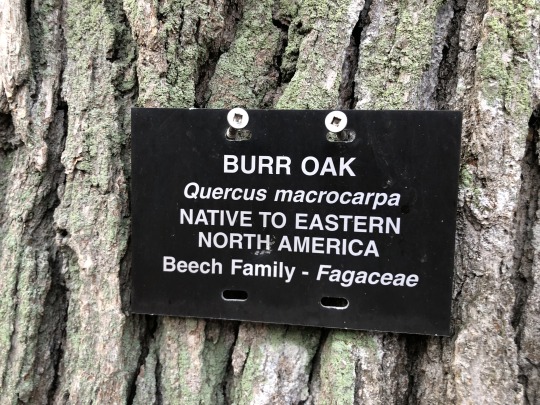

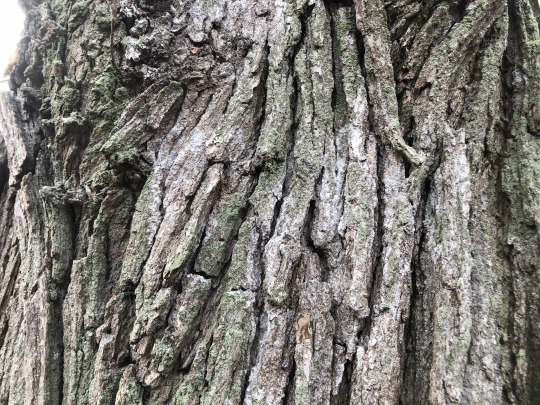
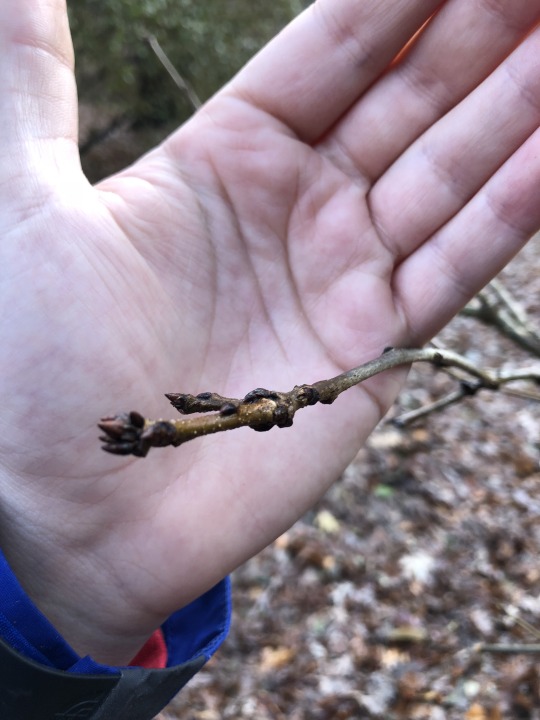

Quercus macrocarpa / Burr Oak
Family: Fagaceae
Native: Northern and central United States, southeastern Canada
Mature Size: 60-80ft height, 60-80ft spread
Habitat: light but rich, medium moisture, soils that drain well;
Hardiness Zone: 3-8
Leaf Color: yellowish-green flowers in the spring; leathery, dark green leaves in the summer
Flower color/Bloom time: Yellowish-green; April
Enclosure:
The Burr Oak is a broad-spreading tree with a rounded crown. The height of this tree in maturity as well as the perceived thickness of the central, vertical trunk indicates that the Burr Oak is suitable for supporting a large treehouse structure. A potential issue with a large structure in this tree, however, is that the branch geometry is diagonal upwards, to the point that branches can not be relied upon for additional structural support. Additional programmatic functions of such a structure could be a hunting post, a wildfire lookout, or a park ranger’s outpost. A treehouse structure of this function can be blended into the landscape by following the height and form of the tree.
Examples of Spiral Treehouse Structures:
1) No-damage spiral staircase: sand-cast aluminum joints cushioned with neoprene pads that rest against the tree (Tadashi Kawamata method).
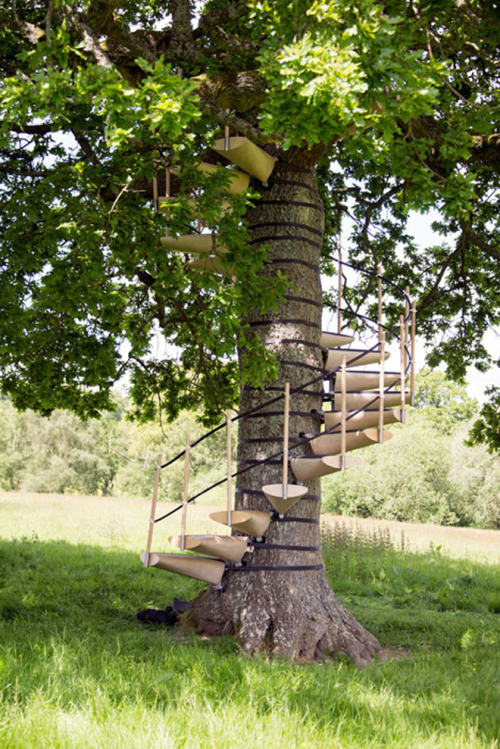
https://www.treehugger.com/sustainable-product-design/canopy-stair-thor-ter-kulve-robert-mcintyre.html
2) Artist Studio in Calvados, France: spiral staircase uses external structural supports and a combination with the Tadashi Kawamata method. The main deck sits on large branches and not directly on the central trunk, but the interaction between the lumber deck on the tree will cause damage.

https://nypost.com/2016/04/25/tour-the-worlds-most-magnificent-treehouses/
Sources:
Lady Bird Johnson Wildflower Center https://www.wildflower.org/plants/result.php?id_plant=QUMA2
Arbor Day Foundation https://www.arborday.org/trees/treeguide/TreeDetail.cfm?itemID=874
Go Botany https://gobotany.nativeplanttrust.org/species/quercus/macrocarpa/
Missouri Botanical Garden https://www.missouribotanicalgarden.org/PlantFinder/PlantFinderDetails.aspx?kempercode=a902
North Carolina Plant Toolbox https://plants.ces.ncsu.edu/plants/quercus-macrocarpa/
Plants for a Future https://pfaf.org/user/Plant.aspx?LatinName=Quercus+macrocarpa
#fagaceae#large structure#small structure#circulation#zone3#zone4#zone5#zone6#zone7#zone8#North America Native#OakHickoryForest
0 notes
Text
Fagus sylvatica

Fagus sylvatica Common Name: European Beech
This tree is a mature Fagus sylvatica, or European Beech. It is recognizable by its smooth, grey bark and its smooth, rhomboid, wavy-edged leaves (alternate-simple). There were also dried husks of beach nuts around the base of the tree. As indicated by its name, Fagus sylvatica is native to Europe and was introduced to the Americas in the mid-1700s by colonists and is now popular as an ornamental and shade tree. It is prized for its mature canopy of 35 to 45 feet in diameter. It can reach heights of 50 to 60 feet but is has a slow to medium growth rate of less than 12-24″ per year. It is an ideal choice for residential areas and parklands but may not withstand the stressors of the urban environment.
Growth Preferences:
Full-sun
Acidic, moist, well-drained soils (loamy, sandy, and clay)
Zones 4-7
Also: Beech nuts are edible! It is not recommended to eat them raw, but they can be roasted after removing the prickly outer husks and smooth inner husks. You can eat them plain roasted as a snacking nut or you can incorporate them into recipes (or get fancy and press them for specialty oil). I found that this site has some useful information regarding harvesting and using beech nuts: practicalselfreliance.com. And as always, remember to forage responsibly!
These photos were taken at Mount Auburn Cemetery in Massachusetts on November 4, 2020
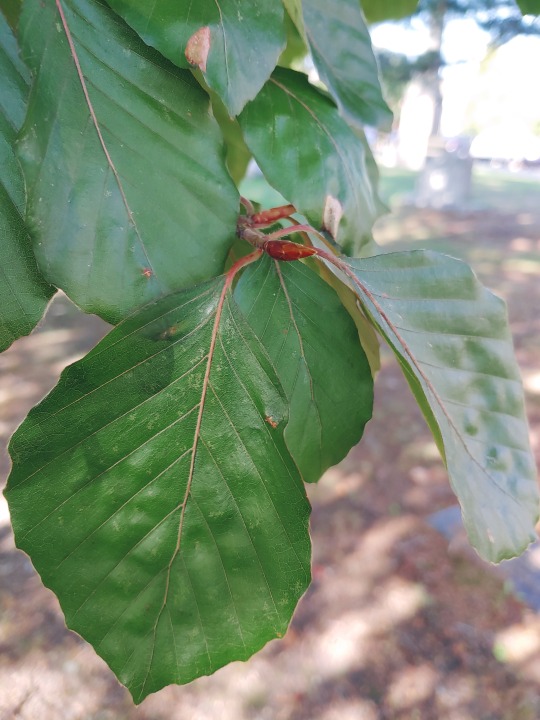
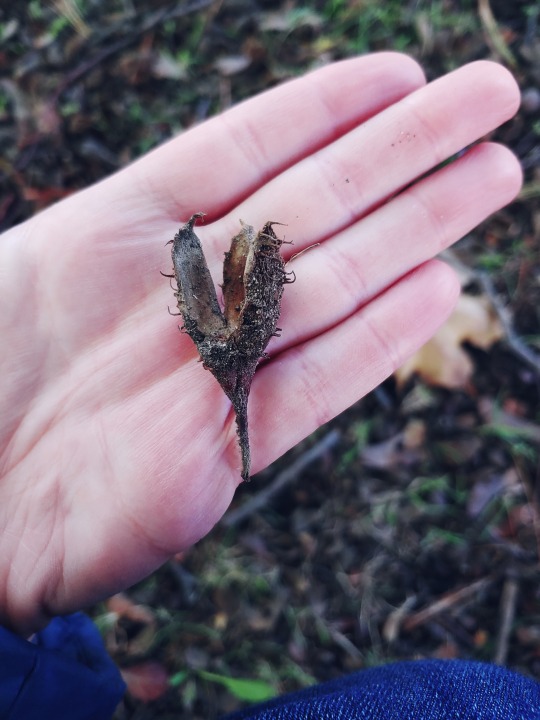


Web References:
https://www.arborday.org/trees/treeguide/TreeDetail.cfm?ItemID=790
https://www.mortonarb.org/trees-plants/tree-plant-descriptions/european-beech
http://www.missouribotanicalgarden.org/PlantFinder/PlantFinderDetails.aspx?kempercode=a866
0 notes